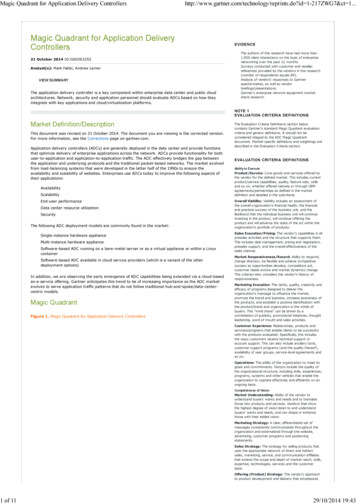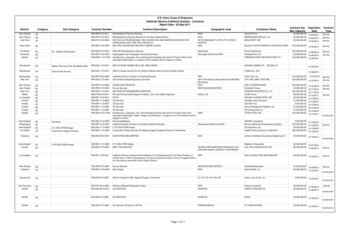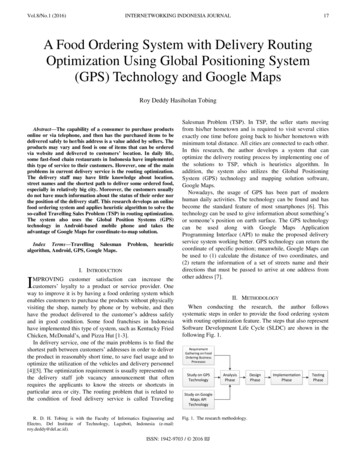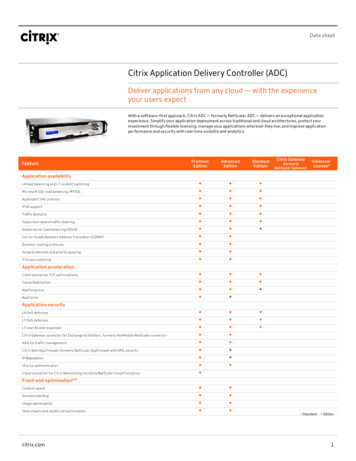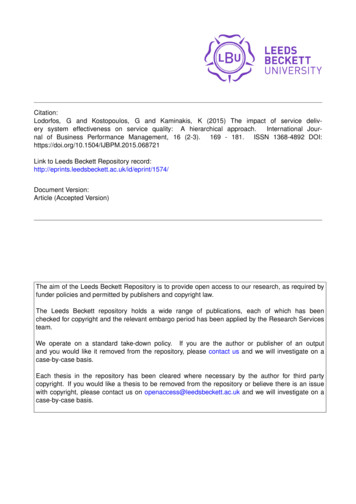
Transcription
Citation:Lodorfos, G and Kostopoulos, G and Kaminakis, K (2015) The impact of service delivery system effectiveness on service quality: A hierarchical approach.International Journal of Business Performance Management, 16 (2-3). 169 - 181. ISSN 1368-4892 DOI:https://doi.org/10.1504/IJBPM.2015.068721Link to Leeds Beckett Repository /1574/Document Version:Article (Accepted Version)The aim of the Leeds Beckett Repository is to provide open access to our research, as required byfunder policies and permitted by publishers and copyright law.The Leeds Beckett repository holds a wide range of publications, each of which has beenchecked for copyright and the relevant embargo period has been applied by the Research Servicesteam.We operate on a standard take-down policy. If you are the author or publisher of an outputand you would like it removed from the repository, please contact us and we will investigate on acase-by-case basis.Each thesis in the repository has been cleared where necessary by the author for third partycopyright. If you would like a thesis to be removed from the repository or believe there is an issuewith copyright, please contact us on openaccess@leedsbeckett.ac.uk and we will investigate on acase-by-case basis.
The Impact of Service Delivery System Effectiveness on Service Quality:A Hierarchical ApproachGiannis Kostopoulos, PhDSenior LecturerSchool of Strategy, Marketing and CommunicationLeeds Metropolitan UniversityEmail: i.kostopoulos@leedsmet.ac.ukGeorge Lodorfos, PhDHead of SchoolSchool of Strategy, Marketing and CommunicationLeeds Metropolitan UniversityEmail: g.lodorfos@leedsmet.ac.ukKostas Kaminakis, PhDAthens University of Economics and BusinessEmail: kkaminakis@aueb.gr1
The Impact of Service Delivery System Effectiveness on Service Quality:A Hierarchical ApproachAbstractThis article focuses on the effectiveness of the Service Delivery System (SDS) and reexamines its influence on customers’ perceived service quality. In this study, the influenceof four specific indicators of the SDS’ effectiveness (namely front line employees’ roleperformance, their adaptability to individual customer needs, the effectiveness of theircoordination and the effectiveness of the service process’ control) on perceived servicequality is tested. In doing so, a hierarchical approach has been taken integrating bothmanagers’ and customers’ views. The results confirm the positive influence of threevariables on perceived service quality (role performance, effectiveness of coordinationand effectiveness of process’ control). On the contrary, the influence of employees’adaptability was not found significant.Keywords: Service delivery system, service quality, employee adaptability2
1. IntroductionDelivering services of high quality is an important pursuit for service providers that seek tocreate and provide value to their customers (Grönroos and Ravald, 2011). Through theprovision of high levels of service quality, companies can achieve increased customersatisfaction, loyalty and therefore long-term profitability (Zeithaml and Bitner, 2000). In orderto provide high levels of service quality and therefore create value for their customers, serviceorganisations need to plan the delivery of their services and to ensure the successfulimplementation of the actual plan (Parasuraman, Berry and Zeithaml 1985, 1988). Therefore,good planning and effective implementation of the developed delivery plans are key factorsfor the Service Delivery System (SDS). Furthermore, continuous improvement of serviceprocedures contributes to the optimisation of SDS and enhances the organisation’s standardsof service.In the pertinent literature, a great numbers of normative studies demonstrate that theeffectiveness of the SDS influences positively and significantly customers’ perceptions of thequality of the service that they receive (e.g. Hensel, 1990; Kingman-Brundage, 1991).Similarly, many studies have proved, through empirical research, the positive influence ofseveral variables of the SDS on perceived service quality (e.g. Parasuraman, Berry andZeithaml 1988; Hartline and Ferrel, 1996).However, to our knowledge, very few studies group specific variables and examine theoverall influence of the SDS Effectiveness on service quality, through the direct influence ofthe individual SDS variables on it. Most studies (Hartline and Ferrell, 1996; Bettencourt andBrown, 1997), both the normative and the empirical ones, either have not focused onparticular variables of SDS effectiveness, considering the SDS as a unified variable andtherefore have not explored individual influences on service quality, or have examined the3
influence of specific variables, but have ignored the role of these variables as indicators of theSDS effectiveness.To fill this gap in the literature, the present study follows a hierarchical approach thatintegrates both the customers’ and the company’s view. On this basis, it attempts to examinethe relationship between four specific indicators of the SDS effectiveness (namely front lineemployees’ role performance, their adaptability to individual customer needs, theeffectiveness of the coordination and the effectiveness of the process’ control) on customers’perceptions on the quality of the provided service.The following paragraphs present at first the underlying theory regarding our study’s corevariables. Next, we develop the research hypotheses of the study’s conceptual framework. Inthe following chapters, the methodology and the results of our empirical investigation aredescribed. Finally, the implications of our findings are presented alongside with the study’slimitations and suggestions for further research.2. Literature ReviewIn general, system effectiveness is described as the capability of producing a specific,desired effect, or in other words “getting the right things done” (Druker, 2004). In a servicesmanagement context, service delivery system is defined as “the structure (facilities,equipment, etc.), infrastructure (job design, skills, etc.) and processes for delivering aservice” (Goldstein et al. 2002, p. 132). From these definitions it becomes apparent that SDSeffectiveness is related to the degree to which a system’s objectives have been achieved andtherefore, an effective SDS is the one that is capable of delivering the outcomes for which itwas originally designed and developed (Kingman-Brundage, 1991). Service delivery systemsnormally should be able to produce several positive outcomes, ranging from reduced costs,4
increased availability of efficient operations, improved service quality and optimum customerexperience (Walley and Amin, 1994).Notably, many scholars have argued that the main aim of a service delivery system is tobridge the gap between customer expectations and customer experience (e.g. Lovelock, 1984;Armistead, 1990). The SDS is in fact the medium through which service employees attempt tomeet the quality standards set by the management, in order to close the third gap of servicesquality, which refers to the gap between service quality specifications and the actual servicedelivery (Parasuraman et al, 1985). Therefore, an effective SDS must lead to high levels ofservice quality both in terms of actual technical quality and it terms of customers’perceptions, since customers are far more likely to evaluate a service positively when thecompany effectively provides the value promised to them (Zeithaml et al, 1988; Parasuramanet al, 1991).In order to assess the effectiveness of the SDS most researchers either measure specificoutputs of the system, such as the times required for task execution, costs, etc. (e.g. Haynesand DuVall, 1992; Mandell, 1991) or use proxy variables and assess the effectiveness of itsmost important determinants (e.g. Ponsignon, Smart and Maull, 2011). In this study, we arefollowing the second approach, identifying the key factors that determine SDS effectivenessand exploring their influence on service quality. Specifically, we argue that the mostimportant determinants of a service system’s effectiveness are the front line employees’ roleperformance, their ability to adapt to individual customer needs, the effectiveness of theircoordination and the effectiveness of the process’ control (Galbraith, 1973; Bettencourt andBrown, 1997). Hence, our conceptual framework describes the direct positive influence of theaforementioned variables on perceived service quality (Figure 1).Insert Figure 15
Employees’ role performance and adaptability are considered as major determinants ofSDS effectiveness, because they reflect the most important outcome of the SDS, which is itsability to satisfy customer needs and create customer value. As an SDS constitutes ofmultiple, interdependent service processes, which are organised hierarchically and areintegrated within a specific process architecture (Sousa and Voss 2006), the coordination andthe control of these service processes should also be taken into account in theconceptualization of SDS effectiveness. This is because these two factors will determine theway this integrated set of processes will be embedded into the service delivery and thereforethe system’s effectiveness.2.2 Employee Role PerformanceService employees, both the ones working in the front line and those who support them inthe back office, are an inseparable part of the service and their performance is crucial for thesuccess of the service delivery (Lovelock, 1985). In order to perform well, front lineemployees must enact their role in the service delivery both efficiently and effectively (Bitneret al, 1997). Their role in the SDS is either provided by their supervisors or described in aformal job description, blueprint etc. and it reflects customer needs, standards set bymanagement and service level agreements. Hence, by effectively performing their predefinedrole, service employees can contribute to the achievement of the company’s quality standardsand bridge the gap between service delivery and customer expectations (Zeithaml et al, 1988).Based on the above arguments is reasonable to suggest that there is strong relationshipbetween employees’ role performance and several positive organizational outcomes, such asincreased service quality (Bowen and Jones, 1986; Hartline and Ferrell, 1996; MacKenzie,Podsakoff and Ahearne, 1998). Therefore, we formulate the following research hypothesis:6
H1: Front line employees’ role performance influences positively customers’ perceptionson the quality of service.2.3 Employee AdaptabilityEmployees’ ability to adapt must not be confused with random deviations in theirbehaviour and performance. This is because only deviations that aim to satisfy specificcustomer needs, contribute to the service delivery (Weitz et al, 1986). Therefore, adoptingprevious definitions, in this study we define employee adaptability as “the ability ofemployees to adjust their behaviour to meet the needs of each customer encounter” (Hartlineand Ferrell, 1996). Based on this definition, employees’ adaptability is a crucial factor in thecompany’s effort to meet the pre-defined quality standards, so is considered as an importantindicator of SDS effectiveness.As noted by previous researchers, front line employees’ ability to adapt to individualcustomers’ behaviour is directly related to service quality (Hartline and Ferrell, 1996; Chebatand Kollias, 2000). More adaptable employees, especially if they are empowered, will find iteasier to offer individual attention to customers and hence satisfy their individual needs(Singh, 2000). On the contrary, employees who do not have the necessary ability orwillingness to adapt their behaviour to the circumstances (e.g. the customer’s needs) and justfollow their supervisors’ instructions cannot deliver high quality of service (Humphrey andAshforth, 1994; Sony and Mekoth, 2012). In fact, satisfied customers most of the timesrecognise employees’ ability to understand their individual needs and offer them a customisedservice as the main source of their satisfaction (Bitner and Hubbert, 1994). Therefore, weformulate the following research hypothesis:H2: Front line employees’ ability to adapt to individual customers’ behaviour influencespositively customers’ perceptions on the quality of service.7
2.4 Effectiveness of Employee CoordinationEmployee coordination describes the degree to which employees work successfullytogether to achieve mutually agreed goals (Ellinger et al, 2011). The effective coordination (orcooperation) of employees has always a beneficial influence on a company’s organizationalfunction (Van de Ven, Delbecq and Koenig, 1976; Galbraith and Lawler, 1993; Gittel andWeiss, 2004). Service providers in particular, always aim to improve the communicationbetween employees and to optimise the way they work together in teams and departments.This is because better coordination among individual employees, apart from improving thecompany’s overall organizational function, also enables organizations to generate value fortheir customers (Zeithaml et al, 1988; Demirbag et al, 2012).For this to happen, both the coordination of tasks carried out from employees that work inthe same department or team and the intra-departmental coordination of activities must beimproved (Saraph et al, 1989). Through successful coordination of activities a serviceorganization avoids double efforts, bottlenecks and miscommunication during the servicedelivery (Lings and Brooks, 1998). By avoiding these operational, organisational andmanagerial failures, the effectiveness of the SDS is ensured and its efficiency is improved,resulting hence in better customer evaluations. Regarding the latter, of great importance is theoptimisation of the coordination between the front line and the back office personnel sincethis is a necessary factor for the success of the service delivery (Zeithaml and Bitner, 2000;Zomerdijk and
organisations need to plan the delivery of their services and to ensure the successful implementation of the actual plan (Parasuraman, Berry and Zeithaml 1985, 1988). Therefore, good planning and effective implementation of the developed delivery plans are key factors for the Service Delivery System (SDS). Furthermore, continuous improvement of service



